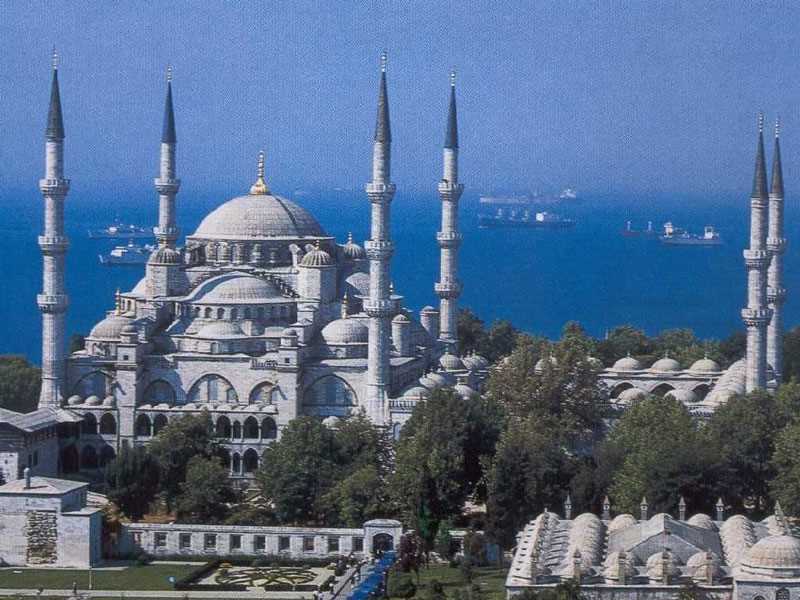One of the greatest works of the architect Sinan Agha. The largest mosque in Istanbul. Sulaymaniyah mosque was named Sultan Suleiman al-Qanuni.
Sulaymaniyah Mosque is located in the Sulaymaniyah district of Al Fateh Province in the European section of Istanbul.
The Sultan Sulaymaniyah Mosque was designed and built by Sinan Agha in 1550 and ordered by Sultan Suleiman the Magnificent in the style of classical Ottoman architecture. It is said that the total of the ten beacon balconies symbolizes the order of Sultan Sulaiman I, the tenth in the series of sultans of the Ottoman Empire.
The story of Sulaymaniyah Mosque
It is said that Sultan Suleiman the Magnificent wanted to build a magnificent mosque and sent to the most famous architects in the Ottoman era Sinan Agha. Before Sinan Agha began to work, he called the most famous craftsmen, architects and technicians to participate in the construction of this great edifice. And prepared the maps, designs, ideas and models, and put them in the hands of Sultan Suleiman, he was impressed by them and gave approval to start work, and open the door of his treasury to implement it without an account, where the disbursement of 996300 pieces of gold for the construction, and this had the effect in unleashing the imagination and experience of Mary Senan Agha to accomplish a university which he has always been proud of. He said: This mosque is my greatest achievement.
The architect Sinan Agha began building the mosque on 13 June 1550 and ended on 15 October 1557. There are many accounts about the construction of the Sulaymaniyah Mosque. One of these accounts is that there was a halt in the construction of the mosque, where after the establishment of Sinan Agha, the foundations of the mosque requested a suspension of construction for a full year to enable the foundations well after many earthquakes passed through Istanbul. In the meantime, the Shah of Iran thought that there were material reasons for the construction of the mosque. He sent a quantity of jewelry to the architects Sinan Agha, which caused Sultan Suleiman's anger and gave the jewelry to Sinan Agha and asked him to put it between the stones. Novels say that this jewelry is hidden today under one of the minarets of the mosque.
The most important characteristic of the Sulaymaniyah Mosque is its construction, reflecting the resonance of the sounds within it. This is what the architect Sinan Agha did. He placed hollow cubes around the perimeter of the dome and different points of the mosque inside. While Sinan Agha spent his time and effort in building this mosque, he conveyed some of his enmity to Sultan Sulaiman that Sinan Agha drank the Nargileh inside the mosque. Sultan Suleiman then angered himself and went to see what was happening. After that Sinan Agha blowing the pipe without tobacco, only to hear the sound of the tap water inside the hookah in the mosque.
Components of Sulaymaniyah Mosque
The mosque is built according to the system of architectural complexes (collective complexes), which is a large building surrounded by a collection of accessories and facilities. The complex consists of: the mosque, the first school, the second school, the third school, the fourth school, the medical school, , The tomb of the Sultan, the tomb of the architect Sinan Agha, the library of the well-known library of Sulaymaniyah (containing about 70,000 manuscripts, 80% in Arabic) ), A hospital and shops.
Building of Sulaymaniyah Mosque
Sulaymaniyah Mosque is undoubtedly the most beautiful and attractive place in the college. The whole is similar to that of his brothers from the architectural works of Sinan Agha. The simplicity of the mosque is simple, but it reflects the beauty and beauty of the mosque. Although the decoration and decoration were used only in the decoration and beautification of the writings, but the engineering design of the mosque remains a marvel of design wonders.
The windows with glazed glass on the wall of the mihrab, as well as the frame of the lateral mihrab, are one of the famous craftsmen of Sarhoush Ibrahim. The large dome of the mosque sits on four huge pink columns. Its depth is twice its diameter. To make the weight of the dome light, a special type of light brick was used for building the dome. in addition to. The stones of the building were bonded and bonded with each other, and the lead was cast on these joints to secure and strengthen them.
The whole is lit through 128 window and dozens of jellyfish. To protect the walls of the mosque from soot emitted from jellyfish and to take advantage of this soot in the manufacture of ink, a room was created at the entrance to the grime for this purpose. On the inner courtyard, called the White Mosque, four minarets with balconies (two with two balconies and two with three balconies) are built, and white marble minarets are built. The number of minarets indicates that Sultan Sulaiman was the fourth caliph after the conquest of Constantinople, while the ten balconies on the minarets indicate that he was the tenth Ottoman Sultan in the Ottoman Empire. In the center of the courtyard is a rectangular fountain with two pieces of mosaics decorated with floral patterns. There is also the Shazroan (place of ablutions).
The length of the mosque of Sulaimaniya about 69 m, and 63 m. The polished Turkish tiles were used with seven shades of shading, including purple red with white and black lines, and the super blue color, which covered the interior walls of the prayer house with its Tulip, Carnation, Jurgis, Chrysanthemum, Chrysanthemum, grape leaves and apple trees. . When you pass to the inner section of the mosque, the architectural beauty and decorations that cover the walls of the mosque take you.
Built on the central dome system, the dome of the main dome above the center of the prayer house is 53 m, and the diameter of 27.25 m, and this dome on four pillars of enormous called the "feet of the elephant" of thickness and magnitude, and stationed near the walls, each length of 7.5 M, and the weight of one of them 60 tons. There is a majestic consistency between the components and elements of this place.
The mihrab and the pulpit are made of engraved marble and the pulpit of the preacher (not the minbar al-khateeb) of engraved wood. In the corners of the mihrab are engraved inscriptions of golden leaves. The sides of the pulpit are decorated with porcelain. The Sultan's Council is located on the north side of the mihrab. In which the prayer takes place. The prayer square takes the shape of the rectangle. It is covered with white marble plates and can accommodate 5000 worshipers. Sinan Agha was entrusted with the most famous calligraphers of his era, such as Hassan Effendi, Chalabi Al-Qahri, who wrote the lines of the mosque, which was very artistic and creative. The walls of the mosque were decorated with verses from the Holy Qur'an. It is said that the Qur'an was revealed in the Hijaz, and read in Egypt and written in Istanbul. On the main entrance in the front, there are places dedicated to women. Behind the prayer house in the Sulaymaniyah Mosque is the courtyard or the inner courtyard. It is rectangular. The floor of this square is covered with large marble panels with two gates on either side and a gate in the middle. An antique door with a crown. It is a unique architectural work. It is a wonderful example of Seljuk art. It is engraved with gold and prominently above it is a certificate of "No god but Allah, Muhammad is the Messenger of Allah".








